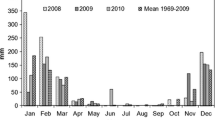Abstract
The VALIMAR project aims at identifyingbiomarkers in fish that are suitable to detectand predict environmental stress from chemicalpollution or from limnological parameters inthe field. For two small streams in SouthernGermany, concentration values of 31contaminants in water and sediment and 12 limnological parameters as well as 27 biomarkersmeasured in brown trout and stone loach werecollected. All these physicochemical andbiological parameters have been analysed forpatterns that discriminate between the streams,using discriminant analysis (DA), analysis ofvariance (ANOVA) and of covariance (ANCOVA), and principal component analysis (PCA) asmultivariate statistical techniques. Moreover,the biological data were analyzed with respectto species-specific patterns, and the partialleast-squares regression method (PLS) was usedto study the impact of chemical and limnological data on the health status of the targetspecies as characterized by the biomarker data.Abiotic as well as biotic data yielded goodseparations between the streams, with theultrastructure of gill (US-gill) being thestrongest discriminator variable among all 27biomarkers tested. With regard to the two fishspecies, the biomarker data from brown troutshow significantly greater differences betweenthe two streams than the biological responsesin stone loach. Application of PLS yieldssignificant regression models for only fewbiomarkers including US-Gill, which can bepartly traced back to significant noise levelsin the data set as quantified by permutationtests.
Similar content being viewed by others
References
Adam, S., M. Pawert, R. Lehmann, B. Roth, E. Müller & R. Triebskorn, 2001. Physicochemical and morphological characterization of two small polluted streams in southwest Germany. J. Aquat. Ecosyst. Stress. Recov. 8: 179-194.
Adams, S. M., K. D. Ham & J. J. Beauchamp, 1994. Application of canonical variate analysis in the evaluation and presentation of multivariate biological response data. Environ. Toxicol. Chem. 13: 1673-1683.
Aries, R. E., Lidiard, R. A. & R. A. Spragg, 1991. Principal component analysis. Chem. Br.: 821-824.
Behrens, A. & H. Segner, 2001. Hepatic biotransformation enzymes of fish exposed to non-point source pollution in small streams. J. Aquat. Ecosyst. Stress. Recov. 8: 281-297.
Einax, J. W., A. Aulinger, W. V. Tümpling & A. Prange, 1999. Quantitative description of element concentrations in longitudinal river profiles by multiway PLS models. Fresenius J. Anal. Chem. 363: 655-661.
Einax, J. W., O. Kampe & D. Truckenbrodt, 1998a. Assessing the deposition and remobilisation behaviour of metals between river water and river sediment using partial least squares regression. Fresenius J. Anal. Chem. 361: 149-154.
Einax, J. W., D. Truckenbrodt & O. Kampe, 1998b. River pollution data interpreted by means of chemometrical methods. Microchem. J. 58: 315-324.
Eriksson, L. & J. L. M. Hermens, 1995. A multivariate approach to quantify structure-activity and structure-property relationships. In: Einax, J. (ed.), Chemometrics in Environmental Chemistry-Applications. The Handbook of Environmental Chemistry (ed. Hutzinger, O.), Vol. 2, Part H, pp. 135-168.
Geladi, P. & B. R. Kowalski, 1986. Partial least squares regression: A Tutorial. Analytica Chimica Acta 185: 1-17.
Gernhöfer, M., M. Pawert, M. Schramm, E. Müller & R. Triebskorn, 2001. Ultrastructural biomarkers as tools to characterize the health status of fish in contaminated streams. J. Aquat. Ecosyst. Stress. Recov. 8: 241-260.
Hollander, M. & D. A. Wolfe, 1973. Nonparametric Statistical Methods. John Wiley & Sons, New York.
Honnen, W., K. Rath, T. Schlegel, A. Schwinger & D. Frahne, 2001. Chemical analyses of water, sediment and biota in two small streams in southwest Germany. J. Aquat. Ecosyst. Stress. Recov., 8: 195-213.
Klecka, W. R., 1980. Discriminant Analysis. Quantitative Applications in the Social Sciences Series, No. 19. Sage Publications, Thousand Oaks, CA.
Köhler, H.-R., C. Bartussek, H. Eckwert, K. Farian, S. Gränzer, T. Knigge & N. Kunz, 2001. The hepatic stress protein (hsp70) response to interacting abiotic parameters in fish exposed to various levels of pollution. J. Aquat. Ecosyst. Stress Recov. 8: 261-279.
Konradt, J. & T. Braunbeck, 2001. Alterations of selected metabolic enzymes in fish following long-term exposure to contaminated streams. J. Aquat. Ecosyst. Stress Recov. 8: 299-318.
Schmitt, H., R. Altenburger, B. Jastorff & G. Schüürmann, 2000. Quantitative structure-activity analysis of the algae toxicity of nitroaromatic compounds. Chem. Res. Toxicol. 13: 441-450.
Schüürmann, G., 1998. Ecotoxic modes of action of chemical substances. In: Schüürmann, G. & Markert, B. (eds), Ecotoxicology, pp. 665-749. John Wiley and Spektrum Akademischer Verlag, New York.
Schüürmann, G., H. Segner & K. Jung, 1997. Multivariate mode-ofaction analysis of acute toxicity of phenols. Aquat. Toxicol. 38: 277-296.
Schwaiger, J., 2001. Histopathological alterations and parasite infection in fish: indicators of multiple stress factors. J. Aquat. Ecosyst. Stress. Recov. 8: 231-240.
StatSoft, Inc., 1999. STATISTICA for Windows '99 Edition. Stat-Soft, Inc., 2300 East 14th Street, Tulsa, OK 74104.
Triebskorn, R., J. Böhmer, T. Braunbeck, W. Honnen, H.-R. Köhler, R. Lehmann, A. Oberemm, J. Schwaiger, H. Segner, G. Schüürmann & W. Traunspurger, 2001. The project VALIMAR (VALIdation of bioMARkers for the assessment of small stream pollution): objectives, experimental design, summary of results, and recommendations for the application of biomarkers in risk assessment. J. Aquat. Ecosyst. Stress recov. 8: 161-178.
Verhaar, H. J. M., L. Eriksson, M. Sjöström, G. Schüürmann, W. Seinen & J. Hermens, 1994. Modelling the toxicity of organophosphorus compounds: A comparison of multiple linear regression and PLS regression methods. Quant. Struct.-Act. Relat. 13: 133-143.
Wold, S., 1995. PLS for multivariate modeling. In: van de Waterbeemd (ed.), Chemometric Methods in Molecular Design, pp. 195-218. VCH Weinheim (Germany).
Zupan, M., J. W. Einax, J. Kraft, F. Lobnik & V. Hudnik, 2000. Chemometric characterization of soil and plant pollution. Part 1: Multivariate data analysis and geostatistical determination of relationship and spatial structure of inorganic contaminants in soil. ESPR-Environ. Sci. Pollut. Res. 7: 89-96.
Author information
Authors and Affiliations
Corresponding author
Rights and permissions
About this article
Cite this article
Dietze, U., Braunbeck, T., Honnen, W. et al. Chemometric discrimination between streams based on chemical, limnological and biological data taken from freshwater fishes and their interrelationships. Journal of Aquatic Ecosystem Stress and Recovery 8, 319–336 (2001). https://doi.org/10.1023/A:1012979502278
Issue Date:
DOI: https://doi.org/10.1023/A:1012979502278




